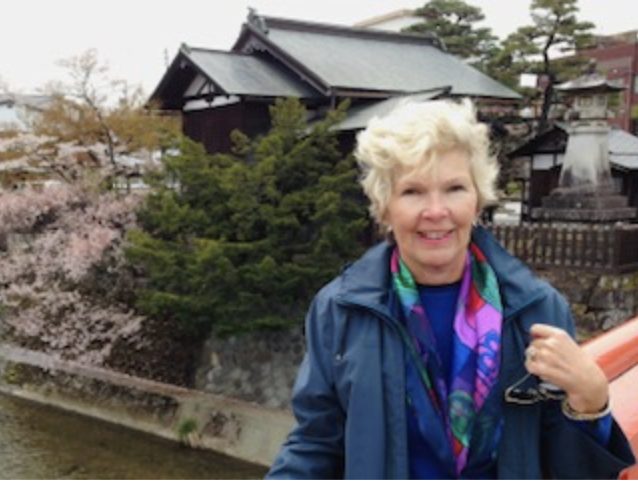
Mariia Novoselia
Staff writer
What’s a good way of declaring true love that was born at first sight? Victorians — and those who attend Mimi Gallo’s lecture — would know the answer is a bouquet of coreopsis, forget-me-nots and blue violets.
Co-founder of Art Partners and chair of the Asian Art and History program at Artis-Naples, Gallo will give this week’s Bird, Tree & Garden Club Brown Bag, “The Language of Flowers,” at 12:15 p.m. today in Smith Wilkes Hall.
In the Victorian era, Gallo said, it was imperative to learn symbolic meanings of different flowers – “if (someone) gives you a bouquet, you need to know what that means.”
For example, blue violets meant love, much like forget-me-nots that expressed sincerity of the sentiment, while a coreopsis represented love at first sight, according to a handout Gallo will use in her lecture.
Victorians, however, were not the only people who attributed different meanings to plants and flowers, she said. A lotus, for example, plays a special role in Chinese culture and is often associated with Buddha.
“(Lotuses) grow in swamps and muck, which is just representing everything awful and evil in the world; and then out of that comes this beautiful, white, pristine flower. You can see that it had a lot of meaning to people,” Gallo said.
Lotuses, she said, are usually the starting point of her lectures. From there, she will talk about the “four gentlemen” in Chinese culture – bamboo, which many don’t even consider a flower, she said, as well as plum blossoms, chrysanthemums and wild orchids. Plum blossoms, she said, usually bloom very early in the season while there is still snow on the ground or the branches, whereas chrysanthemums are the last flower to bloom before winter.
Flowers can also have a medicinal meaning, which Gallo will explain during her talk. She said pansies, for instance, were often believed to cure heart-related troubles because of their resemblance to the organ.
“As far as I know, I don’t think it really worked,” Gallo said. “But the power of belief can make it work just as well.”
“The language of flowers,” she said, will also touch on some important artists like Claude Monet, Édouard Manet and Rachel Ruysch, a “great woman painter of still-lives,” whose “Flowers in a Glass Vase” Gallo will discuss in her lecture.
Popular and expensive, like other works by Ruysch, “Flowers in a Glass Vase” depicts a variety of plants, including tulips, poppies, peonies and lilies, with insects intertwined between the blossoms, as well as fruit and vegetables by the vase.
Because Ruysch painted from real flowers and a lot of flowers in the picture bloom at different times of year, Gallo said, sometimes a painting like “Flowers in a Glass Vase” would take her two years.
Tulips, depicted in the artwork, were particularly popular at the time, Gallo said. Infected by a virus that gave them signature stripes, Gallo said they were sold for about $1,500, which was equivalent to a house back then.
The painting, Gallo said, has both actively blooming as well as wilting flowers, which represents the flow of life.
“You might be beautiful today, but tomorrow you’re going to be ugly, old and dead,” she said.
Gallo will also discuss Georgia O’Keeffe, who created more than 100 paintings of huge flowers in her lifetime. Gallo said O’Keeffe wanted to paint flowers so “big and outrageous” New Yorkers would stop and see them. And they did, she said.
One of Gallo’s passions is women artists, who she said were largely left out of art history books until 1982, despite some of them attending art schools like the University of Bologna around the late 1400s.
“When (O’Keeffe) was painting, she didn’t want to be the greatest woman artist, she wanted to be the greatest artist of her time,” Gallo said. “It shouldn’t make any difference whether you’re a man or a woman. That’s probably one of my favorite topics because it just makes you proud to be a woman. These women did all these things and threw all kinds of diversity; and they were very successful and really geniuses, but not recognized.”
When she was teaching art appreciation, Gallo would ask her students to ponder: “If I was a butterfly landing on these flowers, what would it be like?” Actively involved in the Chagrin Falls School system, Gallo said she was approached by the curriculum director and asked to create an art appreciation program.
“The only reason, I think, she asked me is because she knew I would do it,” Gallo said, noting that she was not a teacher and didn’t have an art history degree — she studied journalism at Northwestern University in Illinois. So she went around and talked to teachers to “see what they want” in order to make the art appreciation program tie in with history, social studies, language and so on.
Soon, Gallo said she found a business partner, with whom she started a nonprofit organization called Art Partners.
“We would train teachers to incorporate art appreciation into the academic classroom and write programs that fit their school curriculum, because if it doesn’t fit in with what they’re doing, they don’t have the time to do all this extracurricular stuff; but if it’s going to enhance the curriculum, then they’ll use it,” she said.
Later, Gallo started sharing her knowledge about art with adults. While not teaching, she is currently chairing a program on Asian art and history. Every year, she said, the committee of eight people, who “have lived all over the world,” chooses a theme and tries to find speakers that can cover it.
In this year’s “Buddhas, Beasts and Beliefs,” the program will touch on the spread of Buddhism from India to Mongolia, and the changes that the religion underwent on the journey among other topics, she said.
Gallo said she hopes her BTG Brown Bag and “the little nitty gritty tidbits” that she’ll share about plants in gardens and on canvases will make gardening for Chautauquans more interesting and personal.




